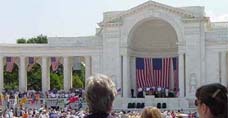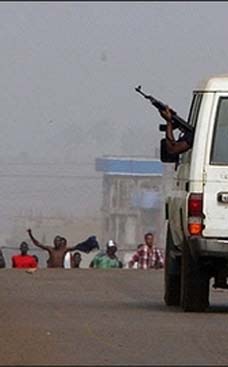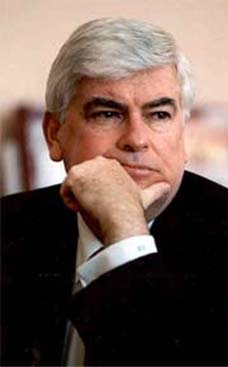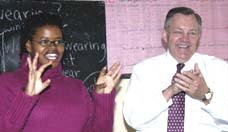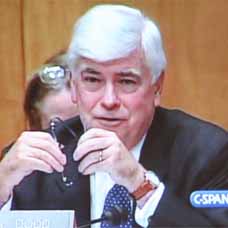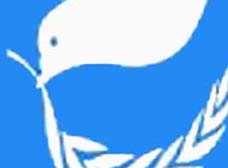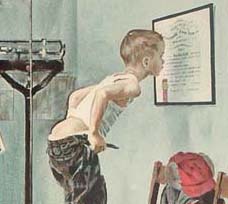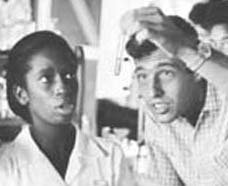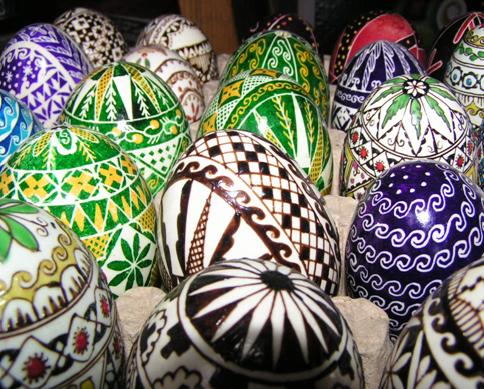
The idea of the project came out as a result of a “Doors to diplomacy” project some of us did last year , about traditional art in Bukovina. We discovered that the way Easter eggs are painted here is probably unique in the whole world. The globalschoolhouse web site also showed us information of Cyberfair where we found out that there is a project category that refers to local art forms. When we saw this year’s theme: Prepare and Unite , we felt that we should involve in a project concerning this form of local art. We also want to thank to our English teacher: Georgeta Costiuc and especially to Ximena Huthnance, our American teacher, a member of the Peace Corps, for her help in improving our English.
Peace Corps Volunteers Ximena Huthnance helps students at 'Eudoxiu Hurmuzachi' National College in Radauti, Bukovina, Romania on cyberproject about traditional art in Bukovina
Title: Easter painted eggs
Category: 8. Local Music and Art Forms
URL: http://www.paintedeggs.3x.ro
Bibliography: http://www.paintedeggs.3x.ro/index_files/indexe_files/Page1884.htm
School: 'Eudoxiu Hurmuzachi' National College
Radauti, Bukovina, Romania
6 students, ages 17-18 worked together to complete this CyberFair project on March 18, 2005. They have participated in CyberFair in the following year(s): 00
Classes and Teachers: Angela Sehlanec/Bota Andrei/Braescu Andreea/Cantoreanu Andra/Carbune Irina/Hreniuc Iulian/Pentiuc Loredana
1. Description of Our Community
We all come from Bukovina,some of us live in Radauti which is a small town. It is located in the North part of Romania and in the South of Bukovina which is considered one of the most beautiful region of our country. Bukovina’s monasteries are recognized all over the world: Bogdana,Voronet, Putna, Sucevita, Moldovita, Dragomirna etc. It is still a region known for its multicultural identity. Here, for centuries, Romanians, Germans, Jews, Polish, Ukrainians , gypsies and others have lived together in peace and understanding. Our community knows the lesson of “living together” in spite of the differences regarding culture, religion, or other things, which includes the respect for each and everyone’s identity. Our school “Eudoxiu Hurmuzachi” National College is more than 130 years old. It has high quality standards of learning, and last school year was one of the top ten high – schools in the country (in an evaluation regarding our pupils results in final exams. The town, situated in an area between Suceava and Sucevita rivers, at 37 km from Suceava, at 375 m altitude, is one of the oldest settlements from Moldavia, known since the 15th century (documentary atestation from 1413) The 'Popular Technics from Bucovina' Museum - Piata Republicii, 63; founded in 1934, Exhibits in 11 halls a rich collection of objects related to traditional occupations of the people from these places and also ceramics from Radauti, Marginea and Kuty (14-15th centuries). The town has also a small Zoological Park and a stud - where the amateurs can ride horses. Local traditions talk about king Radomir , who gave his name to the town: Radomirovti, shortly Radovti, who turned into Radauti. A different version says that the name Radauti comes from the latin “Rothacenum”, where the romans, after the conquest of Dacia, built a strong and organized colony; or, the third version: the name Radauti comes from “village of joy” or “village of wisdom”(see Polish “rada”).
2. Summary of Our Project
The idea of the project came out as a result of a “Doors to diplomacy” project some of us did last year , about traditional art in Bukovina. We discovered that the way Easter eggs are painted here is probably unique in the whole world. The globalschoolhouse web site also showed us information of Cyberfair where we found out that there is a project category that refers to local art forms. When we saw this year’s theme: Prepare and Unite , we felt that we should involve in a project concerning this form of local art. Our tradition is still alive and it is promoted by specific forms: festivals, clubs, magazines and cultural associations. High-school has thought us that if you intend to be fit for the future you should consider Internet and all other facilities that came out of it to be of highest importance. That is what this project is all about. We try to put together old and specific traditions and the wonders of modern life. We couldn’t find anything about this special local art form on the Internet except the things we have on our last year’s site, so we are somehow pioneers in the matter of showing to the whole world these beautiful Easter eggs and information about the way they are being done.
3. Our Computer and Internet Access
A. Percentage of students using the Internet at home: more than 50%
B. Number of workstations with Internet access in the classroom: 2-3
C. Connection speed used in the classroom: dedicated connection
D. Number of years our classroom has been connected to the Internet: 2-3
E. Additional comments concerning your computer and/or Internet access (Optional):
Within the Romanian school system, public school access to the Internet is still limited in certain areas. As for our high-school, being one of the top high-schools in the country, we are proud to say that we benefit of a national program in computer assisted lessons. Our class accesses the Internet as a group only sporadically even if we are a maths-informatics class . At this level , we have studied, this year, among other things, Microsoft Office and also the way to build a web page, so this project is useful for us as an exercise for improving our knowledge in this field. In our school we have three informatics labs, all of them equiped with professional computers and all of them connected to the Internet. If we want to navigate on the Internet at school , first of all , we need the system engineer’s authorization and we have to do this after we finish our classes , when a laboratory is free . At school our Internet access is provided by an antenna connection. At home, some of us are connected to a local area network with Internet access. Those who haven’t Internet access at home had to work in team with the others.
4. Problems We Had To Overcome
We hadn’t any human barriers, our coach helped us remember the timelines and organize the research. It was difficult at the beginning because we couldn’t find information about egg painting on the Internet so we had to search for books and magazines, which weren’t too many either. But the people we talked to were helpful, so most of the things came from person to person contact. There were some technical problems too. We started working on a computer at school, where we could work together. But when we wanted to transfer the pages we had created by e-mail it wasn’t possible. We couldn’t store the information on a floppy-disk, and the computers from the lab didn’t have a cd-writer drive, so we had to ask for help from our system engineer and to use the computer from his office and also his access to the school network. We also had to face the problem of translating a lot of pages into English, but we’ve helped each-other, so the work became easier. There still was a problem of terms: The verbs “to decorate” or “to paint” do not fully cover the meaning of the local Romanian word for this, but we had no other choice because we couldn’t find a similar archaic English word term. The tool that is used to paint the eggs : “chisita” has no equivalent into English. Another problem was with the photos of the eggs. We had to take these photos from close by and some of them were hazy because we aren’t professional photographers and we had usual cameras. We can consider also a problem the fact that in the most important period for finishing the project, the last month, one by one the members of our team got the flow , so the others had to double their efforts to keep the timelines.
5. Our Project Sound Bite
For us this project is important because we realized the importance of the skills and knowledge we achieved from school, and most of all the impact of all these achievements for our future. For most of our teachers it provided an alternative way to evaluate our skills and to have a feedback of their work. It is also a way to thank them for this work with us. We could also prove that we can actively contribute and implicate from an early age , into our community life and culture.
6. How did your activities and research for this CyberFair Project support standards, required coursework and curriculum standards?
We used a lot of things learned in school. Our school curriculum had history classes with knowledge about the evolution of Romanian and universal art and culture. Other school objects like Religion, English language, informatics technology, Literature, Drawing, with all the skill involved by them were of most importance for us. But, because we are a maths – informatics class, these are not the classes with the most important part in our curriculum this year, so we had to work beyond the limited area of a school curriculum. It took us a lot of our spare time, but we are always glad and curious to find out new things. Compared to the last year, this time we have studied this year, during our info classes about techniques of creating web pages so we can consider this project as an extra exercise for school too. That is why we had a lot more support and understanding from our info teacher .
Top
Project Elements
1) What information tools & technologies did you used to complete your CyberFair project?
For realizing this project we have used our personal computer software both at home and at school: Microsoft Window XP, Microsoft Publisher, Microsoft Word, Microsoft Internet Explorer, Paint, Photo Express, telephones to keep contact with each other, several personal digital photo cameras: Minolta Dimage Z1, Sony, Amstrad DC100, our school scanner: Genius. We also had access to the school and the Romanian Academy Research Center libraries in our town , to the local museum and newspaper articles. Most of the artists were orally interviewed.The most helpful were the computers ,the photo cameras and the scanner which provided us the possibility to transfer all the images with the eggs into the web site
2) In what ways did you act as "ambassadors" and spokespersons for your CyberFair project both on-line and in person.
First of all we had to persuade our school community that we are seriously involved in this project. Of course we had support from our teachers, that helped us organize a few meetings, together with other teams involved in similar projects (Doors for example), with our school masters and our informatics teachers. We made a brief report of the involvements of such a project, our objective being, beside our personal achievements, to make our school, our region, a certain part of our traditional art, known to the whole world by means of the Internet. Thus we obtained their support, we had access in one of our info labs when we needed it, and we had help from our teachers when we asked for it. Extending our area of work, we had to explain our goal to certain members of our local community. Our literature teacher made us an appointment to the manager of the Museum. He was really interested in everything we told him, so he agreed to give us the interview, to let us make photos, he provided us research material and helped us contact some of the local artists. Of course, from the very beginning we had our families’ support. We were even glad to find interesting things about Easter traditions from some of our grandparents and relatives that were happy to share with us their memories. All of them, even most of our classmates, helped us gather information, and even a collection of painted eggs of our own . We asked some of our school mates that collaborate to our local radio to help us make publicity to our project. In this way we were contacted by some local artists like Mrs. Oresia L. Finally we asked our classmates and all our friends to sent our web site address by mail to al their acquaintances, and so did we ourselves, in order to make it known to other people.
3) What has been the impact of your project on your community?
Our web site makes a difference because most of the people we’ve contacted could see that nobody is isolated in modern life and know how to keep contact with the others. Internet offers an enormous benefit for all of us. The team from the museum offered us all the information they thought might be useful, because the museum hasn’t a site of its own, so they were glad to find out that we had a section of the site dedicated to the museum. They even asked us if we would like to work on a site for the museum in the future. Then, there were the artists. Most of them understood that our project is an opportunity for them to be known outside our community or continental borders and that Internet can be useful for their business too, because, as we said, they also earn their living by selling the painted eggs as souvenirs. Although most of them are housewives, they understand, for example, how the photos we’ve made can be seen on their P.C . by a lot of people and thus their products are promoted. As a future impact we hope that our whole site will contribute in attracting more tourists to our beautiful region. Our teachers and friends from school appreciated how we were able to go beyond our class curriculum and, although our class type is based on math and informatics, physic and technology. We had also full support from our parents. When they began to see the results of our research, they were glad we showed interest in traditional art and not only in computer games or music, which are specific to our age. They also understood that we are able to use the knowledge and skills we learned in school in a practical way that can be useful to us in the future.
4) How did your project involve other members of your community as helpers and volunteers?
We couldn’t do this without help. Except our coach, that helped us inform, organize and conduct the research, there were a lot of people we want to thank to for school: Mrs. Antoneta Lazarescu, Angela Ionascu, Angela Mocrei, that allowed us to work in the labs, sometime over the daily program. They also gave us technical advice when we needed it. We also want to thank to our English teacher: Georgeta Costiuc and especially to Ximena Huthnance, our American teacher, a member of the Peace Corps, for her help in improving our English. Also, we have special thanks for our Religion teacher: Postolache Miriam, and to our history teacher, Olaru Marian , that provided us access to the library of the Romanian Academy Research Center from our town, where we had the permission to borrow rare, precious and old book from 1906 written by Leonida Bodnarescu, a local folklorist ( see the Bibliography page). Last but not least we wish to thank to our parents for their support, as they were our main sponsors (for phones, traveling and the use of personal technical device).
5) Discoveries, Lessons and Surprises (Optional)
Through this project we found out that one our classmates is actually painting Easter eggs every year, a skill inherited from her grandmother. At the same time we were surprised to meet artists in our town ,which means that it isn’t only a rural tradition. We also found out that the drawings on the eggs aren’t just casual combinations of colors but old and traditional motifs which are strictly used each year by the women that practice this custom. We were pleasantly surprised to see that a lot of people from our local community became more interessed by our art values .
For more information visit the web site here.
